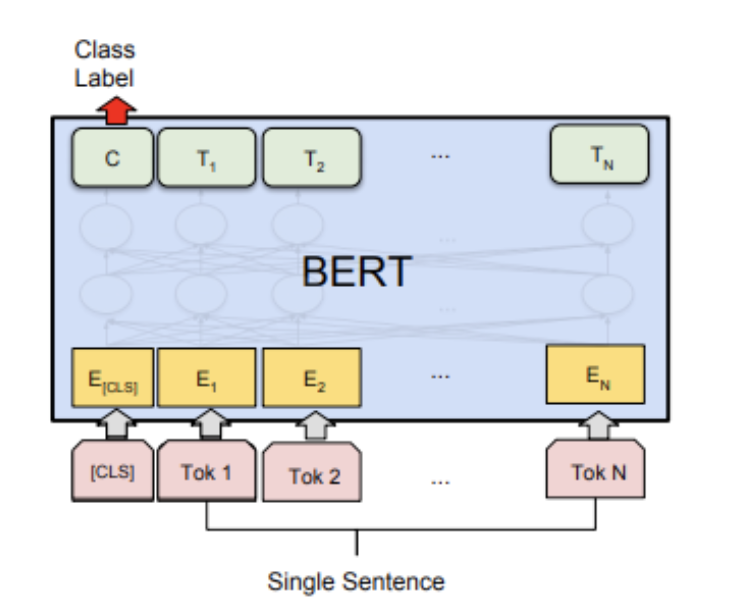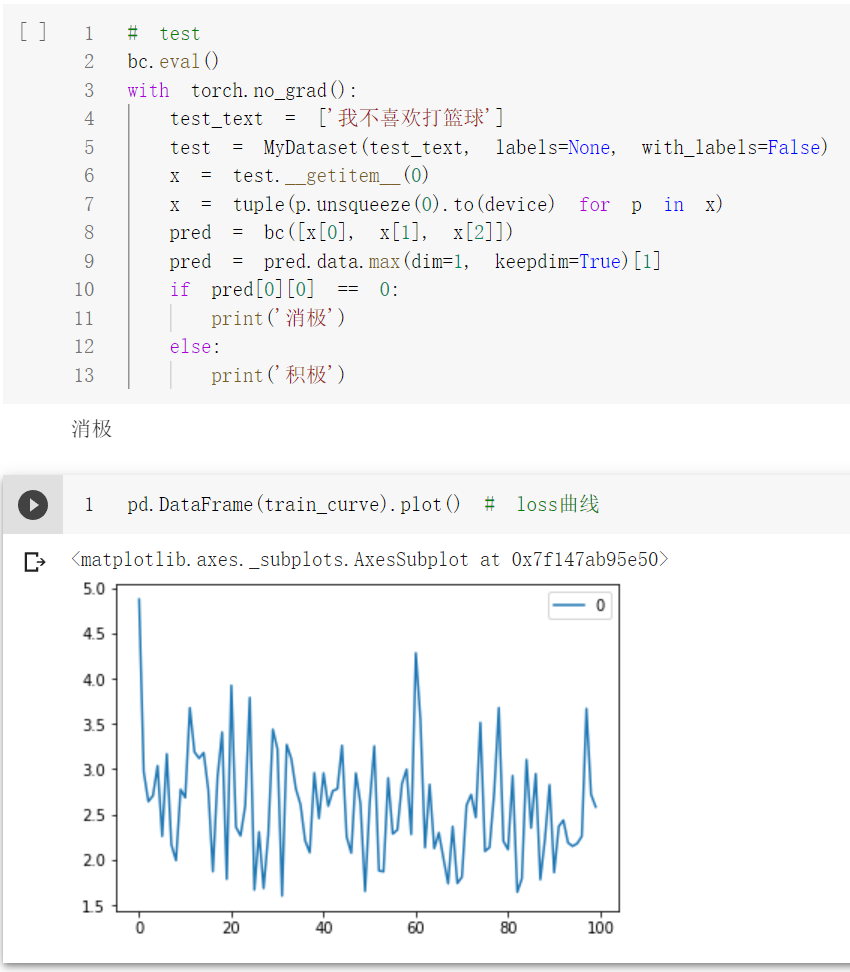Bert文本分类实践(一):实现一个简单的分类模型
写在前面
文本分类是nlp中一个非常重要的任务,也是非常适合入坑nlp的第一个完整项目。虽然文本分类看似简单,但里面的门道好多好多,作者水平有限,只能将平时用到的方法和trick在此做个记录和分享,希望大家看过都能有所收获,享受编程的乐趣。
第一部分
模型
Bert模型是Google在2018年10月发布的语言表示模型,一经问世在NLP领域横扫了11项任务的最优结果,可谓风头一时无二。有关于Bert中transformer的模型细节,推荐看这篇。在此不做赘述。

Bert文本分类模型常见做法为将bert最后一层输出的第一个token位置(CLS位置)当作句子的表示,后接全连接层进行分类。模型很简单,我们直接看代码!
第二部分
pytorch代码实现
# -*- coding:utf-8 -*-
# bert文本分类baseline模型
# model: bert
# date: 2021.10.10 10:01
import os
import numpy as np
import pandas as pd
import torch
import torch.nn as nn
import torch.utils.data as Data
import torch.optim as optim
import transformers
from transformers import AutoModel, AutoTokenizer
import matplotlib.pyplot as plt
train_curve = []
device = torch.device('cuda' if torch.cuda.is_available() else 'cpu')
# 定义一些参数,模型选择了最基础的bert中文模型
batch_size = 2
epoches = 100
model = "bert-base-chinese"
hidden_size = 768
n_class = 2
maxlen = 8
# data,构造一些训练数据
sentences = ["我喜欢打篮球", "这个相机很好看", "今天玩的特别开心", "我不喜欢你", "太糟糕了", "真是件令人伤心的事情"]
labels = [1, 1, 1, 0, 0, 0] # 1积极, 0消极.
# word_list = ' '.join(sentences).split()
# word_list = list(set(word_list))
# word_dict = {w: i for i, w in enumerate(word_list)}
# num_dict = {i: w for w, i in word_dict.items()}
# vocab_size = len(word_list)
# 将数据构造成bert的输入格式
# inputs_ids: token的字典编码
# attention_mask:长度与inputs_ids一致,真实长度的位置填充1,padding位置填充0
# token_type_ids: 第一个句子填充0,第二个句子句子填充1
class MyDataset(Data.Dataset):
def __init__(self, sentences, labels=None, with_labels=True,):
self.tokenizer = AutoTokenizer.from_pretrained(model)
self.with_labels = with_labels
self.sentences = sentences
self.labels = labels
def __len__(self):
return len(sentences)
def __getitem__(self, index):
# Selecting sentence1 and sentence2 at the specified index in the data frame
sent = self.sentences[index]
# Tokenize the pair of sentences to get token ids, attention masks and token type ids
encoded_pair = self.tokenizer(sent,
padding='max_length', # Pad to max_length
truncation=True, # Truncate to max_length
max_length=maxlen,
return_tensors='pt') # Return torch.Tensor objects
token_ids = encoded_pair['input_ids'].squeeze(0) # tensor of token ids
attn_masks = encoded_pair['attention_mask'].squeeze(0) # binary tensor with "0" for padded values and "1" for the other values
token_type_ids = encoded_pair['token_type_ids'].squeeze(0) # binary tensor with "0" for the 1st sentence tokens & "1" for the 2nd sentence tokens
if self.with_labels: # True if the dataset has labels
label = self.labels[index]
return token_ids, attn_masks, token_type_ids, label
else:
return token_ids, attn_masks, token_type_ids
train = Data.DataLoader(dataset=MyDataset(sentences, labels), batch_size=batch_size, shuffle=True, num_workers=1)
# model
class BertClassify(nn.Module):
def __init__(self):
super(BertClassify, self).__init__()
self.bert = AutoModel.from_pretrained(model, output_hidden_states=True, return_dict=True)
self.linear = nn.Linear(hidden_size, n_class) # 直接用cls向量接全连接层分类
self.dropout = nn.Dropout(0.5)
def forward(self, X):
input_ids, attention_mask, token_type_ids = X[0], X[1], X[2]
outputs = self.bert(input_ids=input_ids, attention_mask=attention_mask, token_type_ids=token_type_ids) # 返回一个output字典
# 用最后一层cls向量做分类
# outputs.pooler_output: [bs, hidden_size]
logits = self.linear(self.dropout(outputs.pooler_output))
return logits
bc = BertClassify().to(device)
optimizer = optim.Adam(bc.parameters(), lr=1e-3, weight_decay=1e-2)
loss_fn = nn.CrossEntropyLoss()
# train
sum_loss = 0
total_step = len(train)
for epoch in range(epoches):
for i, batch in enumerate(train):
optimizer.zero_grad()
batch = tuple(p.to(device) for p in batch)
pred = bc([batch[0], batch[1], batch[2]])
loss = loss_fn(pred, batch[3])
sum_loss += loss.item()
loss.backward()
optimizer.step()
if epoch % 10 == 0:
print('[{}|{}] step:{}/{} loss:{:.4f}'.format(epoch+1, epoches, i+1, total_step, loss.item()))
train_curve.append(sum_loss)
sum_loss = 0
# test
bc.eval()
with torch.no_grad():
test_text = ['我不喜欢打篮球']
test = MyDataset(test_text, labels=None, with_labels=False)
x = test.__getitem__(0)
x = tuple(p.unsqueeze(0).to(device) for p in x)
pred = bc([x[0], x[1], x[2]])
pred = pred.data.max(dim=1, keepdim=True)[1]
if pred[0][0] == 0:
print('消极')
else:
print('积极')
pd.DataFrame(train_curve).plot() # loss曲线
测试单条样本结果:

代码链接:
jupyter版本:https://github.com/PouringRain/blog_code/blob/main/nlp/bert_classify.ipynb
py版本:https://github.com/PouringRain/blog_code/blob/main/nlp/bert_classify.py
喜欢的话,给萌新的github仓库一颗小星星哦……^ _^



 浙公网安备 33010602011771号
浙公网安备 33010602011771号